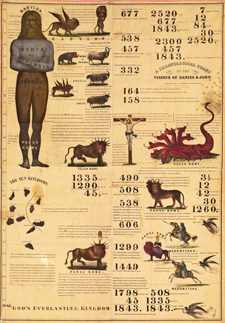
Is 2520 a Prophetic Number?
The Millerites did not have PowerPoint® presentations to illustrate their messages; they used a variety of charts instead. One of these was the 1843 chart published by Joshua V. Himes. In 1850, Otis Nichol, one of the early Seventh-day Adventists, published a similar chart with the same numbers, except that 1843 was changed to 1844.
The 1843 chart has in the right-hand top corner a time prophecy of 2520 years, based on the “seven times” in Leviticus 26:28, which the Millerites believed refers to the punishment of God’s people beginning in 677 B.C. and ending in 1843, when Jesus would come again and cleanse the earth with fire.
Some Adventists today claim that the 2520-year prophecy was correct and still needs to be proclaimed. They find support for this view in a statement by Ellen G. White, where she says, “I have seen that the 1843 chart was directed by the hand of the Lord, and that it should not be altered; that the figures were as He wanted them; that His hand was over and hid a mistake in some of the figures, so that none could see it, until His hand was removed.”1 One of the mistakes was, of course, the figure 1843, but what was wrong in other figures?

The King James Version of Leviticus 26:28 reads: “I will walk contrary unto you also in fury; and I, even I, will chastise you seven times for your sins.” Misunderstanding the term “seven times,” they believed that the word time refers to a prophetic year, and by multiplying 360 x 7 they came to 2520 years. The KJV rendering can be misleading; the New American Bible, therefore, correctly translates “‘“I . . . will chastise you with sevenfold fiercer punishment for your sins.”’” The Hebrew text has only the word seven; there is no reference to a time period. “Seven (fold or times)” is a proverbial expression for the full, complete measure of discipline. (It is also used in Leviticus 26:21, 24, 28; and Psalm 79:12.) Seven was an appropriate number of completeness in view of the importance of seven in the Israelite religion.
According to the Millerites, 677 B.C. was the year in which King Manasseh (696-642 B.C.) was taken as a prisoner to Babylon (2 Chron. 33:11) and the 2520 years of punishment of God’s people began. There is no historical evidence, however, that Manasseh was taken to Babylon in 677 B.C. This year goes back to the chronology of James Ussher in the 17th century.
Manasseh was coregent with his father Hezekiah for the first 10 years of his reign. His sole reign of 42 years began in 686 B.C. If his imprisonment and subsequent conversion occurred in 677 B.C., nine years after the beginning of his sole reign, he still reigned for more than 30 years after his conversion and return to Judah, but this is not the picture the Bible presents of Manasseh’s reign. The Bible gives the impression that most of his life was spent in apostasy and that only toward the end of his life did he turn to the Lord. Speaking about Manasseh’s conversion, Ellen White wrote that his “repentance, remarkable though it was, came too late to save the kingdom from the corrupting influence of years of idolatrous practices. Many had stumbled and fallen, never again to rise.”2
Many Bible scholars believe that his imprisonment took place in connection with the rebellion of Assurbanipal’s brother Samassumukin during the years 652–648 B.C. Yet, even if the date 677 B.C. were correct, it would not indicate the beginning of the punishment of God’s people, because only the king was taken to Babylon, and only for a short time. He returned to Jerusalem, destroyed all the idols he had erected, and restored the worship of God (2 Chron. 33:15, 16). The kingdom of Judah continued another 80 years, until in 586 B.C. Nebuchadnezzar destroyed Jerusalem and the temple of God. These 80 years included the reign of good King Josiah (640–609) whose reign can in no way be classified as a punishment on Judah. In other words, the year 677 B.C. does not fit historically or chronologically.
Like Deuteronomy 28, Leviticus 26 contains blessings for obedience and punishments for disobedience. Verse 3 says, “‘“If you walk in My statutes and keep My commandments, and perform them,”’”3 then follow the blessings up to verse 13. Verse 14 reads: “‘“If you do not obey Me, and do not observe all these commandments,”’” then follow threatened judgments up to verse 39. Following the initial threatened judgments in verses 15–17, verse 18 says, “‘“After all this, if you do not obey Me, then I will punish you seven times more for your sins.”’” Three more times God repeats this threat (26:21, 24, 28), each further judgment is increased seven times or sevenfold in severity.
That the expression “seven times” cannot refer to seven time periods is indicated by the following:
1. The Hebrew only has the word seven; the word time does not appear in the text.
2. The year-day principle is valid only in the apocalyptic books of Daniel and Revelation or in texts where it is specifically explained. Leviticus 26 is not an apocalyptic book. The year-day principle, therefore, cannot be used. There are only two texts in non-apocalyptic books where the year-day principle is used (Num. 14:34; Eze. 4:6), and both times God explains that a day stands for a year. In apocalyptic books this is not stated but assumed.
3. The last judgment also threatens exile: “‘“I will scatter you among the nations”’” (Lev. 26:33). This was fulfilled in the northern kingdom Israel in 722 B.C. through the Assyrian exile and in the southern kingdom through the Babylonian exile from 605 B.C. on. This judgment, therefore, cannot be applied to the Christian era.
4. The Millerites saw only the last “seven times” in verse 28 as a time prophecy. If they had used all four “seven times,” the time period would have extended to 10,080 years.
In 1864, James White published an article in The Review and Herald titled “The Seven Times of Lev. Xxvi.” In this article he asked the question, “Is there any prophetic period brought to view at all in Lev. xxvi?” In response he says, “We claim that there is not, and will offer a few of what are to us very conclusive reasons for this position.”4 He asks, “What is meant by this repeated expression of seven times? We reply, It denotes, not the duration of the punishment, but its intensity and severity. It is well expressed in the language of verse 21, thus: ‘I will bring seven times more plagues upon you according to your sins.’ The number seven denoting perfection, we are undoubtedly to understand by this expression, the fullness of their punishment; that the measure of their national sins would in every case be fully equaled by the measure of their national calamities.”5
He concludes that portion of the article by stating, “So then, there is no prophetic period in Lev. xxvi; and those who imagine that such a thing exists, and are puzzling themselves over the adjustment of its several dates, are simply beating the air. To ignore, or treat with neglect, a prophetic period where one is plainly given, is censurable in the extreme. It is an equally futile, though not so heinous, a course, to endeavor to create one where none exists.”6
The 1843 chart was used by the Millerites with good success, but not everything on the chart is correct. To see in Leviticus 26 a time prophecy of 2520 years is historically and exegetically impossible.
Ellen White’s confirmation of the 1843 chart refers to the 1260- and 2300-year prophecies, not to the figure of 2520, which she never used because it is not a time prophecy.
NOTES AND REFERENCES
1. Early Writings, p. 74.
2. Prophets and Kings, p. 382.
3. Unless otherwise noted, all Scripture references in this article are quoted from the New King James Version.
4. James White, “The Seven Times of Lev. Xxvi,” Review and Herald (January 26, 1864), p. 68.
5. Ibid.
6. Ibid.
